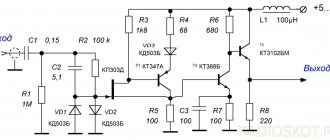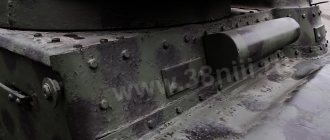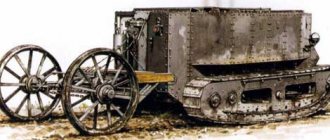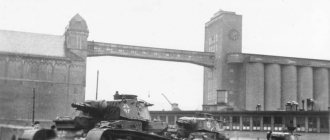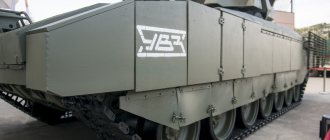Serial modifications of the MS-1 tank:
MS-1 (T-18) arr. 1927 - the hull and turret were riveted and assembled on a frame. The tower is hexagonal, with a mushroom-shaped observation turret. The engine was located across the body and was made in one block with the main clutch and gearbox. There was a “tail” at the rear of the hull.
MS-1 (T-18) arr. 1930 - turret with a rectangular aft niche, 40 hp engine. p., four-speed gearbox, cast drive wheel. Combat weight 5.68 tons. Dimensions 4350x1760x2120 mm. Ammunition: 104 rounds, 2016 rounds. Speed max. – 17.5 km/h.
Since 1929, MS-1 tanks began to enter service with newly formed mechanized units. They were actively used for training purposes - 103 vehicles immediately after production were transferred to the disposal of OSOAVIAKHIM and a number of military-technical educational institutions.
The MS-1 received its baptism of fire in November 1929 during the Soviet-Chinese armed conflict on the Chinese Eastern Railway. A separate tank company, numbering 9 combat vehicles, took part in the hostilities.
Since 1938, tanks began to be handed over to the URs on the western border of the USSR for use as both mobile and fixed (with the removal of the engine and chassis) firing points. At the same time, some of the combat vehicles were rearmed with a 45-mm tank gun mod. 1932
These tanks took part in the border battles of the summer of 1941, and in some cases, not without success. The latest facts about the combat use of the MS-1 relate to the Battle of Moscow. In particular, the 150th Tank Brigade in the winter of 1941/42 had 9 tanks of this type.
Tank MS-1 mod. 1927
T-18 (MS-1), Light tank
MS-1—LIGHT INFANTRY TANK
MS-1, or T-18, is a light infantry tank whose name stands for “Small Escort”.
In the mid-20s of the last century, tanks in the USSR were divided not in the classic way for today: Heavy, Medium and Light, but in a different way: Small, Main and Maneuverable. The MS-1 was precisely a “Small” class tank, hence part of its name. In the 20s, the USSR really needed its own tanks, but there were no specialists or base to begin work. There was, however, a Renault Russian tank, which was developed during the Civil War. It was rejected, according to an extract from one report on this tank: “...very unsatisfactory in terms of workmanship, inconvenient to wield weapons, and partially and completely unarmed..”
Therefore, it was decided to buy one of the samples of such equipment from abroad. The first to look was the French tank Reno FT-17, which was already enjoying great success in Europe. But it had a number of disadvantages: heavy weight (the USSR military command planned to transport tanks on trucks), low speed and poor weapons (37 mm guns had an effective range of 400 m). After the Renault tank was rejected, they found a tank that was most suitable for the prototype of the new Soviet tank - the Italian Fiat 3000. As a result, one sample vehicle was purchased and sent to the design bureau. In March 1927, a prototype was built under the designation T-16. Tests revealed a number of shortcomings in the chassis, and after they were corrected, the tank was named T-18. Presumably on May 20-25, the tank was sent to Moscow for state testing. It is worth noting that the tank did not have a cannon until now, that is, tests were carried out with a mock-up of the gun. The gun was eventually installed the same as that of the French Renault. MS-1 was put into service on July 6 of the same year. Produced until 1931. Operated until the 1950s.
Armament: • 37 mm gun • Ammunition, sn. — 96 • Initial flight speed of an armor-piercing projectile, m/s, — 600 • Initial flight speed of a sub-caliber projectile, m/s, — 705 • Sighting range, m, — Approximately 500 • Vertical aiming angles, degrees: -8°…+ 30° Armor penetration: • Armor-piercing, at a distance of 100 m, mm/deg. — 29/60° • Armor-piercing, At a distance of 500 m, mm/deg. — 23/60° • Armor-piercing, At a distance of 1 km, mm/deg. — 16/60° • Rate of fire, rds/min – up to 6 Additional weapons: Two 6.5 mm Fedorov machine guns. One is paired with a cannon. The other is installed in the right frontal part of the tower. • Weight, t - 5.3 • Crew, h - 2. Commander (also gunner and loader), Driver. • Hull length, mm - 3500 • Hull width, mm - 1760 • Height, mm - 2030 Armor: Hull forehead, mm/deg. 16 Hull side, mm/deg. 16 Hull feed, mm/deg. 16 Bottom, mm 8 Hull roof, mm 8 Turret forehead, mm/deg. 16 Tower side, mm/deg. 16 Tower feed, mm/deg. 16 Tower roof, mm 8 Driving performance: • Engine power, l. With. — 25 • Maximum speed, km/h — 16 • Cruising range on the highway, km — 100 • Specific power, l. s./t - 6.6 • Climbability, degrees. — 36°
Modifications: • T-18 arr. 1929 - Ammunition increased to 104 shells. • T-18 arr. 1930 - Slightly reduced in size. Instead of two Fedorov machine guns, one Dyagterev machine gun is installed. A more powerful engine of 40 hp, as a result of which the maximum speed increased to 22 km/h. • T-18M - The dimensions of the tank have increased, it has become even larger than the usual MS-1. The ammunition load increased to 112 rounds, but as a result, the ammunition capacity for the machine gun decreased by 500 rounds. New engine with 50 hp power. significantly improved driving characteristics. The maximum speed has increased to 24 km/h. Vehicles based on MS-1 • SU-18 - Self-propelled unit. It had a 76-mm regimental gun. Not accepted for service due to the fact that the MS-1 chassis could not withstand a 76-mm cannon shot. • TT-18 - Teletank. It was controlled using three-command control: “Right, left, stop.” It was not accepted for service for the reason that, with a very low mass, the tank swayed from side to side when moving due to the smallest bumps and stones, and thus it could not move straight, as the commission required. • XT-18 - Chemical tank. Possessed chemical protection against various poisonous gases. He was armed with a spray gun that could spray poison gas and create smoke screens. Tanks with a substance of 60 liters made it possible to infect or smoke almost 2 km of extended terrain. Not adopted for service in favor of OT-1. • MS-1 was also used as a transporter for ammunition and engineering vehicles.
Combat use
Conflict on the Chinese Eastern Railway (October-December, 1929) - During the battles, tank formations behaved uncoordinated, but during the entire conflict they did not suffer losses. The damaged tanks were repaired. Great Patriotic War (1941-1942) - At the beginning of the Second World War, 160 MS-1 tanks and 450 fixed combat points (based on MS-1) were in service. The latest data on the use of MS-1 refers to December-February 1941-42. 9 MS-1 tanks took part in the Battle of Moscow. These tanks did not participate in battles anymore.
Tactical and technical characteristics of the MS-1(T-18) tank, model 1927:
- COMBAT WEIGHT, t: 5.3.
- CREW, people: 2.
- OVERALL DIMENSIONS, mm: length – 4400, width – 1760, height – 2120, ground clearance – 315.
- ARMAMENT: 1 Hotchkiss or PS-1 cannon of 37 mm caliber, 2 Fedorov machine guns of 6.5 mm caliber or 1 DT machine gun of 7.62 mm caliber.
- AMMUNITION: 96 rounds, 1800 rounds.
- AIMING DEVICES: diopter or 2.45x optical sight.
- RESERVATION, mm: front, side, rear and roof of the hull – 16, bottom – 8, turret – 16.
- ENGINE: special tank designed by A. Mikulin, 4-cylinder, 4-stroke, in-line, carburetor, air-cooled; power 35 l. s. (25.6 kW) at 1800 rpm, working volume 3200 cm3.
History of Soviet tank building. Part 1
Before the advent of tanks, the army already used armored vehicles, such as armored cars and armored trains. However, these machines were quite limited in application. The former lacked cross-country ability even if they had a combined wheeled-tracked undercarriage, while the latter were tightly tied to the railways. The need to create an armored self-propelled combat vehicle with all-terrain capability was understood by the military of each of the leading powers in Europe.
The Russian Empire was no exception. At the beginning of the 20th century, tanks were also invented here. Even those who are fairly superficially interested in the history of armored vehicles are well aware of such projects as Porokhovshchikov’s “All-terrain vehicle”, Lebedenko’s “Tsar Tank” or Vladimir Mendeleev’s super-heavy tank. And there were other developments: Gunter Burshtyn’s tank, Demyanenko’s “Ground Battleship”, Kazansky’s “Armored Tractor”. In general, there were enough ideas - both quite sane and frankly erroneous. Another thing is that there was no time for their implementation. In 1917, two revolutions happened in Russia, after which the country, frankly speaking, had no time for tanks.
But not for long. In August 1919, the Council of People's Commissars and the Council of Military Industry of the RSFSR decided to organize the production of Renault FT tanks in Nizhny Novgorod. From this time begins the history of the tank building industry of the Soviet Union.
The Soviet version of the Renault tank was not a 100% copy of its French prototype. When the sample arrived at the plant, it turned out that some parts had not reached their destination. The most unpleasant surprise for the engineers was that the gearbox was among the missing components. The plant engineers, headed by N.I. Khrulev and P.I. Saltanov, were forced to design the lost parts on their own. Their work was successful, and in 1920 the very first Soviet tank, “Freedom Fighter Comrade Lenin,” rolled off the assembly line.
Only 15 Russian Renaults were produced. There was not enough industrial resource for more. At that time, the USSR was still a rather backward state from an industrial point of view, and a lot of effort had to be made to change the situation.
Despite the weakness and inadequacy of the industry, work on the design of tanks in the USSR was carried out quite actively. The first competition for the best project was held in 1920. Its winner was a ten-ton amphibious tank designed by engineer Kondratiev. This was an independent development, not based on imported prototypes. At a similar competition in 1922, 7 projects were already presented.
In 1923, the Main Directorate of Military Industry became in charge of issues of armored vehicles. In 1924, a special Tank Bureau was created under him, which began work on May 6. The bureau was supposed to collect and systematize existing experience, study tank construction, train human resources and, finally, develop its own tank model. The latter was especially relevant in the conditions of the difficult political situation in which the USSR was located, and the fact that the state of the fleet of foreign equipment in service with the Red Army could not be called anything other than deplorable.
At the initial stage of work, it was planned to design three types of tank: a heavy breakthrough vehicle, a maneuverable tank for mobile units, and a small one to support infantry. In October 1925, after a meeting on the problems of tank construction in the Mobilization and Planning Directorate of the Red Army, work on the heavy tank was practically stopped.
The “small” tank was made in metal already in 1927. It still very much resembled the Renault Russian, but the design also included a number of borrowings from the Italian Fiat 3000. The new Soviet tank, assembled at Leningrad, received the T-16 designation and went for testing in March. It turned out that the car has many shortcomings in the chassis and power plant. Until the summer, improvements were underway, and after state tests on June 11–17, 1927, the improved tank, already with the new designation T-18, was adopted by the Red Army under the designation “Small Escort Tank Model 1927” (MS-1).
The technical specifications for the “maneuverable” tank were formulated in November - December 1927. The development was entrusted to the Ordnance Arsenal Trust together with the design bureau of the Kharkov plant, which opened in October of the same year. The trust did not react too warmly to the task and tried to shift most of the work to the Kharkovites, although they did not yet have experience in designing armored vehicles. The result was something like this. Muscovites were to develop the hull and turret, and Kharkovites were to develop the transmission and chassis. But since the Muscovites did not show zeal, several employees of the Kharkov plant went to the capital and worked with them.
It is appropriate to mention here that starting from October 1928, a young draftsman A. A. Morozov, a future outstanding tank designer and twice Hero of Socialist Labor, joined the design bureau of the Kharkov plant.
The T-12 was designed taking into account the experience gained during the creation of the MS-1, as well as using the idea of a multi-tiered arrangement of weapons, which in the mid-20s was actively developed by the Americans on experimental medium tanks. The T-12 was supposed to have two rotating turrets. The gun room should have contained a 45 mm gun or a 57 mm howitzer. The small turret, located on the roof of the cannon house, housed a coaxial 7.62 mm machine gun mount.
This scheme had two drawbacks at once. Firstly, when the main turret rotated, the sight of the small turret inevitably got lost. Secondly, due to the two-tier layout, the height of the vehicle was almost three meters, which was a bit much for a tank even at that time.
Construction of the experimental T-12 took place from October 13, 1928 to October 15, 1929. Official acceptance of the prototype took place in February 1930, and the first stage of testing began in April.
As in the case of the MS-1, the first tests showed serious shortcomings in the engine and chassis. After they were eliminated, the tank was demonstrated to a commission headed by K.E. Voroshilov, I.A. Khalepsky and G.G. Bokis. Here the car performed well, but the designers were instructed to modify the T-12.
The development of the car was, in fact, a deep modernization. The design bureau of the Kharkov Locomotive Plant completely redesigned the arrangement of internal modules, changed the design of the tower, and achieved an increase in the power reserve. The modernized tank, designated T-24, was adopted by the Red Army in August 1930, but mass production was not possible due to technical and economic reasons. Only 25 copies of the T-24 were delivered to the troops. They did not take part in hostilities and were used only as training ones. Already in 1931, the design bureau of the Kharkov plant switched to work on the design of wheeled-tracked tanks of the BT series. Because of this, his boss left the design bureau, who did not agree with such a change in the vector of activity. Shortly thereafter, the T-24 was finally dropped from production plans.
You can discuss the material here.
Go to the second part of the material.
T-18 (MS-1)
the second
serial Soviet tank
In the first interwar years, Soviet Russia had no time for tanks. However, when production began to recover in the second half of the 20s, the idea of producing tanks again arose in the minds of members of the Revolutionary Military Council, and in 1926 a three-year tank building program was adopted.
The program provided, as a minimum plan, for the organization of one tank battalion and training company equipped with infantry tanks, as well as one battalion and company equipped with wedges. According to calculations, this required the production of 112 vehicles of each type. In September, a meeting was held between the command of the Red Army, the leadership of the GUVP and the Ordnance Arsenal Trust (OAT), dedicated to issues of tank construction and the selection of a tank for the upcoming mass production. The FT-17 was considered overly heavy, slow-moving, and poorly armed, and the Soviet-produced version was expensive and of poor quality. The cost of one Renault-Russian was 36 thousand rubles, which did not meet the requirements of the three-year program, which provided for a total cost of 5 million rubles for its implementation, with the cost of one infantry tank being 18 thousand rubles. Here it must be said that the ruble in those years was equal to the tsarist one, and therefore this sum now, as of the end of October 2010, is equal to 19 million modern Russian rubles or 608 thousand dollars. Modern tanks, of course, do not cost that much - the T-90, for example, is purchased by the Russian army for 70 million rubles ($2.2 million), and the price of the American Abrams starts at $4.3 million. But the equipment of the then and modern tanks also cannot be compared.
To study foreign experience, over the previous two years there was a study of captured foreign tanks, of which the most favorable impression was made by the Italian Fiat 3000, which was an improved version of the FT-17. In accordance with the requirements of the commission, the Tank Bureau developed a design for a tank, designated T-16.
To speed up the work, the tank, which had the best production capacity at that time, was allocated to produce a prototype of the tank. By March 1927, the T-16 prototype was completed. While generally similar to the FT-17, the new tank, due to its better layout, had a significantly shorter hull length and, as a result, less weight and better mobility; Its cost turned out to be significantly lower compared to Renault-Russian. At the same time, tests of the T-16 revealed many shortcomings, mainly in the power plant and chassis. The second prototype, during the construction of which these comments were taken into account, was completed by May of the same year and received the designation T-18. On June 11-17, the tank was subjected to state tests, which were generally successful, and as a result of which it was put into service on July 6 under the designation “small escort tank mod. 1927" (MS-1) or T-18.
On February 1, 1928, the first order was issued for the production of 108 serial T-18s during 1928-1929. The first 30 of them, built with funds from OSOAVIAKHIM, had to be delivered before the fall of 1928, and the plant successfully completed this task. Since April 1929, the Motovilikha Machine-Building Plant, which was a backup for the production of the T-18, was connected to the production of the tank, but the development of production there was slower, especially since it depended on the supply of the engine, transmission, tracks and armor.
The first T-18s began to enter service with the troops in 1928, and by the next year they took the place of the main tank in service with the Red Army. Of the total number of tanks of this type produced, 103 vehicles were immediately transferred to the disposal of OSOAVIAKHIM and other military-technical educational institutions, 4 were transferred to the OGPU, 2 to the Fourth Directorate and 1 to the Military Chemical Directorate of the Red Army, the rest entered service with various armored units. T-18s were actively used for combat training of both armored units and other types of troops practicing anti-tank defense tactics.
By 1929, the T-18 no longer met the increased requirements of the Red Army and therefore underwent significant modernization: engine power was increased from 35 to 40 hp. s., and a four-speed gearbox and a new multi-disc clutch were introduced into the transmission.
T-18s were first used in combat during the conflict on the Chinese Eastern Railway in November 1929. In the fall, the Transbaikal Group of the Special Far Eastern Army (ODVA) was assigned a company of 10 tanks, one of which was severely damaged during transportation and dismantled for spare parts to repair the remaining nine. These nine took part in the Mishanfu offensive operation on November 17-19, 1929.
The tanks began moving to their original positions late in the evening of November 16, but they were not fully fueled and had almost no ammunition for their guns, and three vehicles were not equipped with machine guns. During the night march, without even a map of the area, the tanks lost each other and only four of them arrived at the intended point. Here they were refueled and received 40 shells for the gun, after which on the morning of November 17 they proved themselves to be quite successful in the assault on Chinese positions. Two of the lagging tanks reached the location of other Soviet units, where, lacking shells, they still managed to support the attack of the infantry of the 106th Infantry Regiment, who used them to provide cover from enemy fire. By the middle of the day, these two tanks nevertheless joined the rest and the company, already consisting of six vehicles, attempted to storm the Chinese fortifications, but was stopped by an anti-tank ditch. The company did not suffer any combat losses during the day, but two tanks failed due to technical reasons, although one of them was repaired on the same day. By evening, two more lagging tanks arrived, wandering across the steppe after the loss of the detachment until they ran out of fuel, and the third had a gearbox failure.
Production of the T-18 continued until the end of 1931, when it was replaced in production by a new infantry escort tank, the T-26. Some of the vehicles produced in 1931 were accepted for military acceptance only at the beginning of 1932. therefore, some sources say that production of the T-18 was completed in 1932. In total, over four years of production, in four production series, 959 serial T-18 tanks of all modifications were manufactured. Some sources also contain a figure of 962 tanks, but this also includes prototypes.
However, the T-18 continued to remain in service. In 1933, the design bureau developed a tank modernization project, designated MS-1a. It was distinguished from the serial T-18 by its chassis, which included on each side one and a half bogies with an elastic element in the form of leaf springs from the T-26 tank and support rollers from the same. It was assumed that with this it would be possible to increase the life of the chassis and the speed of movement, as well as reduce the longitudinal vibrations of the tank while moving. However, tests of the prototype, which began on May 19, 1933, showed that its mobility even worsened and further work on the MS-1a was stopped. When in 1937 the Automotive and Tank Directorate was tasked with modernizing the outdated models of armored vehicles that remained in service, the T-18 became one of the first candidates for it. The modernization project, designated T-18M, was developed in 1938 at the design bureau of plant No. 37 under the leadership of N. A. Astrov. The main change was the replacement of the worn-out power plant with a 50 hp GAZ M-1 engine. s., which was also installed on the small T-38 tank and the installation of a gearbox, drive wheels and a turning mechanism taken from it, similar to side clutches. In this regard, the shape of the hull was slightly changed, which also lost its “tail”. The chassis was also modified, and the turret was made lighter by eliminating the rear niche and changing the shape of the commander's cupola. The tank was equipped with a 37-mm B-3 cannon, which by that time had already been mass-produced for several years. A single prototype of the T-18M was built and tested in March 1938. Based on their results, it was noted that despite the obvious increase in the characteristics of the tank, modernization also created some new problems. In general, it was concluded that the combat value of the T-18M does not justify the costs of modernizing the existing tank fleet, and therefore further work in this direction was stopped.
By the beginning of 1938, the T-18s still in service had reached extreme levels of wear and tear. By that time, 862 tanks remained in service, including 160 transferred in 1934-1937 to the fortified areas (hereinafter fortified area, UR) of the Leningrad Military District for the construction of bunkers. The remaining cars have already been sent for scrap. But even the tanks that formally remained in service were mostly in disrepair, and many were also disarmed (the guns transferred to arm the T-26 tanks were dismantled from the T-18 unit). The situation was aggravated by the lack of spare parts, which units received only by dismantling some tanks to repair others. In connection with this order of the People's Commissar of Armaments of March 2, T-18s were removed from service and 700 of them were transferred to the disposal of fortified areas of military districts. The tanks transferred to the fortified areas were subject to re-equipment with twin machine guns DT, DA-2 or 45-mm cannon mod. 1932. Engines and transmissions were dismantled from faulty tanks, and armored hulls were buried turret-deep in the ground or simply installed as BOTs (armored firing points) at bridges, road intersections and in other places convenient for defense. The tanks, which retained the ability to move under their own power, were transferred to the garrisons of fortified areas for use as mobile firing points. By the beginning of the Great Patriotic War, the troops still had about 450 armored hulls and 160 tanks. Converted into bunkers, T-18s were mainly concentrated on the western borders of the USSR; a number of them were also installed in the fortification system in the area of Lake Khasan, where an armed conflict with Japan took place in 1938.
The last known combat use of the T-18 dates back to the Battle of Moscow, in which in the winter of 1941-1942, 9 T-18s from the 150th Tank Brigade were used, which, according to documents, were in service until February, when the brigade still had three such tanks .
| Number and percentage of Russians by regions of the Russian Federation |
| Peoples of Russia, their number and percentage |
| Soviet aces of World War II |
| It was impossible to do without the Molotov-Ribbentrop Pact |
| Gold reserves of countries around the world |
| Gold and foreign exchange reserves of the world's countries |
| Does Russia need a gold ruble? |
| How America Got Rich |
| Rating of countries in the world by the number of armed forces |
| Who sold Alaska and how |
| Why we lost the Cold War |
| The mystery of the 1961 reform |
| How to stop the degeneration of a nation |
| Why were Chechens and Ingush deported in 1944? |
| Which country drinks the most? |
| Which country has the most murders? |
| How did the Russian worker live before the revolution? |
| What is the value of the Soviet ruble in today's money? |
| What Russia exports and what it imports |
| History of the Moscow tram |
| Cartoon "Guest from the Future-2" |
| The world's first machine gun and its inventor |
| Soviet prices for cars and motorcycles in rubles and salaries |
Add to your Facebook
—>
Tweet
Russian tanks from Vezdekhod to T-90
Uniforms and insignia of the armies of the Second World War
| A complete list of heads of Government of Our Country from 1802 to the present day... |
| Full list of Russian cities |
| Russian armored cars |
| Russian measures: arshin, barrel, bucket, verst, vershok, share, inch, spool, line, pud, fathom, point, pound, glass, scale, shtof |
| The letter “е” (yat) and its spelling |
Russian fighters
